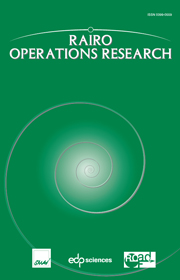Article contents
Multi-objective geometric programming problem withKarush−Kuhn−Tucker condition using ϵ-constraintmethod
Published online by Cambridge University Press: 10 June 2014
Abstract
Optimization is an important tool widely used in formulation of the mathematical modeland design of various decision making problems related to the science and engineering.Generally, the real world problems are occurring in the form of multi-criteria andmulti-choice with certain constraints. There is no such single optimal solution existwhich could optimize all the objective functions simultaneously. In this paper,ϵ-constraint method along with Karush−Kuhn−Tucker (KKT) condition has been used tosolve multi-objective Geometric programming problems(MOGPP) for searching a compromisesolution. To find the suitable compromise solution for multi-objective Geometricprogramming problems, a brief solution procedure using ϵ-constraint method hasbeen presented. The basic concept and classical principle of multi-objective optimizationproblems with KKT condition has been discussed. The result obtained by ϵ-constraint method withhelp of KKT condition has been compared with the result so obtained by Fuzzy programmingmethod. Illustrative examples are presented to demonstrate the correctness of proposedmodel.
Keywords
- Type
- Research Article
- Information
- Copyright
- © EDP Sciences, ROADEF, SMAI 2014
References
- 7
- Cited by


